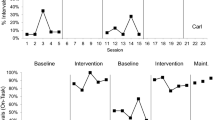Abstract
Self-management strategies have been shown to be widely effective. However, limited classroom-based research exists involving low performing but developmentally normal high school-aged participants. This study examined the effectiveness of a self-management strategy aimed at increasing on-task behavior in general education classrooms with students without a diagnosed disability, behavior disorder, or exceptionality. The self-management package included provision of a tactile prompt, training in self-monitoring and data recording, self-monitoring, and the plotting of the results on a cumulative graph. A multiple baseline design across three participants was used to evaluate the effects of the intervention. An increase in on-task behavior was observed with all participants on implementation of the self-management package, and questionnaire-based social validity findings suggest this was an acceptable and effective procedure for the classroom context. Limitations, implications, and future directions of these findings are discussed.

Similar content being viewed by others
References
Amato-Zech, N., Hoff, K., & Doepke, K. (2006). Increasing on-task behavior in the classroom: Extension of self-monitoring strategies. Psychology in the Schools, 43, 211–221.
Asaro-Saddler, K., & Saddler, B. (2010). Planning instruction and self-regulation training: Effects on writers with autism spectrum disorders. Exceptional Children, 77, 107–124. doi:10.1177/1053451208330895.
Axelrod, M., Zhe, E., Haugen, K., & Klein, J. (2009). Self-management on on-task homework behavior: A promising strategy for adolescents with attention and behavior problems. School Psychology Review, 38, 325–333.
Ballard, K. D., & Glynn, T. (1975). Behavioral self-management in story writing with elementary school children. Journal of Applied Behavior Analysis, 8, 387–398.
Brigham, T. A., Hopper, C., Hill, V., Armas, A. D., & Newsom, P. (1985). A self-management program for disruptive adolescents in the school: A clinical replication analysis. Behavior Therapy, 16, 99–115.
Broden, M., Hall, R. V., & Mitts, B. (1971). The effect of self-recording on the classroom behavior of two eighth grade students. Journal of Applied Behavior Analysis, 4, 191–199.
Dalton, T., Martella, R., & Marchand-Martella, N. (1999). The effects of a self-management program in reducing off-task behavior. Journal of Behavioral Education, 9, 157–176.
Davies, S., Jones, K., & Rafoth, M. (2010). Effects of a self-monitoring intervention on children with traumatic brain injury. Journal of Applied School Psychology, 26, 308–326.
De Haas-Warner, S. (1992). The utility of self-monitoring for preschool on-task behavior. Topics in Early Childhood Special Education, 12, 478–495.
Delano, M. E. (2007). Improving written language performance of adolescents with Asperger syndrome. Journal of Applied Behavior Analysis, 40, 345–351. doi:10.1901/jaba.2007.50-06.
Epstein, M. H., Mooney, P., Reid, R., Ryan, J. B., & Uhing, B. M. (2005). A review of self-management interventions targeting academic outcomes for students with emotional and behavioral disorders. Journal of Behavioral Education, 14, 203–221.
Glynn, E. L., & Thomas, J. D. (1974). Effect of cueing on self-control of classroom behavior. Journal of Applied Behavior Analysis, 7, 299–306.
Holifield, C., Goodman, J., Hazelkorn, M., & Helfin, L. (2010). Using self-management to increase attending to task and academic accuracy in children with autism. Focus on Autism and Other Developmental Disabilities, 25, 230–268.
Kazdin, A. (2010). Single case research designs. Oxford: Oxford University Press.
Kennedy, C. H. (2002). The maintenance of behavior change as an indicator of social validity. Behavior Modification, 26, 594–604.
Lee, S., Simpson, R., & Shogren, D. (2007). Effects and implications of self-management for students with autism: A meta-analysis. Focus on Autism and Other Developmental Disabilities, 22, 2–13.
Moore, D. W., Prebble, S., Robertson, J., Waetford, R., & Anderson, A. (2001). Self-recording with goal setting: A self-management programme for the classroom. Educational Psychology, 21, 255–259.
O’Reilly, M., Tiernan, R., Lancioni, G., Lacey, C., Hillery, J., & Gardner, M. (2002). Use of self-monitoring and delayed feedback to increase on-task behavior in a post-institutionalized child within regular classroom settings. Education and Treatment of Children, 25, 91–102.
Piersal, W. C. (1985). Self-observation and completion of school assignments: The influence of a physical device and expectancy characteristics. Psychology in the Schools, 22, 331–336.
Rafferty, L. A., Arroyo, J., Ginnane, S., & Wilczynski, K. (2011). Self-monitoring during spelling practice: Effects on spelling accuracy and on-task behavior of three students diagnosed with attention deficit hyperactivity disorder. Behavior Analysis in Practice, 4, 37–45.
Rock, M. L. (2005). Use of strategic self-monitoring to enhance academic engagement, productivity, and accuracy of students with and without exceptionalities. Journal of Positive Behavior Interventions, 7, 3–17.
Rock, M. L., & Thread, B. K. (2007). The effects of fading a strategic self-monitoring intervention on students’ academic engagement, accuracy, and productivity. Journal of Behavioral Education, 16, 389–412.
Shogren, K., Lang, R., Machalicek, W., Rispoli, M., & O’Reilly, M. (2011). Self-versus teacher management of behavior for elementary school students with Asperger syndrome: Impact on classroom behavior. Journal of Positive Behavior Interventions, 13, 87–96.
Soares, D., Vannest, K., & Harrison, J. (2009). Computer aided self-monitoring to increase academic production and reduce self-injurious behavior in a child with autism. Behavioral Interventions, 24, 170–183.
Author information
Authors and Affiliations
Corresponding author
Rights and permissions
About this article
Cite this article
Moore, D.W., Anderson, A., Glassenbury, M. et al. Increasing On-Task Behavior in Students in a Regular Classroom: Effectiveness of a Self-Management Procedure Using a Tactile Prompt. J Behav Educ 22, 302–311 (2013). https://doi.org/10.1007/s10864-013-9180-6
Published:
Issue Date:
DOI: https://doi.org/10.1007/s10864-013-9180-6




